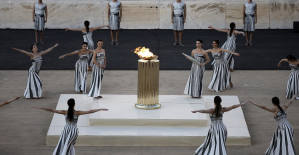Already in the 19th century, Crete, then still under Ottoman occupation, attracted travelers. The American writer Henry Miller followed in the late 1930s, became an ascetic on the island, was fascinated by Knossos, Phaistos, the old Minoan high culture: "Crete is able to silence the mind, to still the turmoil of thoughts."
Tourism flourished soon after World War II. Some flew to the north coast for a package holiday, others preferred the hinterland, hiked in the White Mountains, which are called Lefka Ori in Greek, to the fishing village of Loutro, which to this day can only be reached on foot and by boat. They followed the hippies to the cave bay of Matala, where the Romans had already buried their dead. Or they retreated to a monastery in the mountains to read Homer or Plato in the original.
And today? Are there still enough destinations for individualists beyond the big hotels of Heraklion and Rethymno with their jet skis, beach bars and banana boats, after all Crete is Greece's largest island. If you can, come in spring when it's emptier and not as hot as in summer. It is the ideal time for hiking, it is green and blooming everywhere. The sea is still too cold for most people in spring, but of course there are hardened people who take a bath even when the water temperature is below 20 degrees.
It is worth staying longer than a week - nevertheless, in the end you will only have seen a fraction of the 260-kilometer-long island: from Kissamos to Sitia, from west to east, it is five hours on a well-developed road. Away from that, detours are worthwhile to beautiful places with old-fashioned cafes, to meadows with beehives and wild thyme, to monasteries and secluded rocky bays, over hairpin bends and mountain passes (the highest peaks reach a good 2400 meters into the sky).
Everywhere you meet people who seem to live by the motto of Nikos Kazantzakis, Crete's most famous poet: “I hope for nothing. I fear nothing. I am free.” Crete has 635,000 inhabitants, but 35 million olive trees, nature and culture, mountains and sea. Here, Henry Miller wrote, everyone is seized with the desire to "bathe in heaven." You just have to know where. Eight tips for island spring.
Of course, nothing comes close to the 16-kilometer Samaria Gorge, Crete's most famous hiking route. Once on holiday you have to go through them - preferably early in the morning before all the buses arrive - and hike down step by step from an altitude of over 1200 meters to the Libyan Sea: Once there after four to seven hours, hikers stay until the evening, when the ferries leave which bring the vacationers to the waiting buses. On the way back through the Omalos plateau you can see goats and sheep on the road - the wild west of Crete.
If you only want to hike for an hour, take the small gorge at Meskla. Bizarre, narrow rock faces, plane trees, climbing in the dry river bed, even children can do it. On the way look out for and follow the sign for "Emilia's Tavern": The eatery in the village of Zourva rewards you with fresh orange juice, rabbit in white wine, yoghurt with walnuts and honey, served on the terrace at the foot of the White Mountains. Conveniently, the only way to get to the imposing church of Meskla is downhill.
Elafonisi is considered to be Crete's most beautiful beach, pink and white in the extreme southwest, but is hopelessly overcrowded, even in spring Instagrammers pose here for supposedly paradisiacal selfies. So where to go? For example to Balos in the west of the island. This beach with its turquoise-white lagoon is much lonelier because it can only be reached by ferry or via a gravel path and a sweaty staircase. If you want, you can collect sea salt on the beach, free of charge. Even hippies still exist, they live in huts hidden under tamarisk trees.
More accessible but not overcrowded is Falasarna, one of the longest beaches in the west. The children's beach of the tavern "Kapetan Nikolas" is pink and flat, "Bird Away" has beach beds and lounge music. Everyone will find their bay here, and in the evening their table with a sea view on the terrace of the tavern "Galasia Thea", which opens again in spring after the winter break.
The "Sinagogi Cafe Bar" is not so easy to find in the tangle of alleys of the old town of Chania, perfect for an espresso on ice or for a cocktail in the evening. A few houses away you ring the bell at the wooden gate of the Etz Hayyim synagogue. Not an easy visit: In 1944, more than 250 Jews from Crete were crammed onto a ship from Chania by German occupiers. Their destination: Auschwitz. Accidentally fired upon by a British submarine, it sank. None of the deportees survived.
In 1999 the synagogue was rededicated. Etz Hayyim means tree of life - one provides shade in the yard. A quiet, cool place to think about for a long time.
Surfers gravitate to Palekastro to the east. The wind is always blowing in the bay not far from the village. The road there and further towards Chiona is winding, the landscape barren - a journey into nothing, apart from the armada of wind turbines.
The journey is worth it, Chiona Beach, a pebble beach with a table mountain, is the perfect place by the sea: make a reservation on the rock of the "Taverne Chiona". Order swordfish steak and stuffed vine leaves while the waves crash and everything blurs into a blue, sea and sky. It's hard to find a nicer place to eat on the island.
One of Crete's wealthiest monasteries, Toplou, makes fantastic Syrah: 101 Portes, named after the number of monastery doors. And sweet red wine that tastes of candied fruit: Philotheos. That's the name of the clever Abt, who already relied on organic wine in the 90s.
The monastery, built in the 14th century, resembles a fortress and has often been attacked. Visitors have to walk it, preferably up early, down after the wine tasting, past vines and bananas to the famous palm beach Vai with the largest natural palm grove in Europe. He belongs to the monastery.
In the remote mountain village of Zakros, men sit in the shade in front of the kafenion (as traditional Greek cafés are called) and watch as tourists set off into the nearby gorge, the “Valley of the Dead”, in the midday heat. In ancient times, the Minoans buried their ancestors in the caves there.
Hikers follow the gully to the river, through the dense oleander forest. Red rocks, blue flowers. Halfway there is the skeleton of a goat. So there is still something to the name. After two hours, at the end of the hike, the valley widens, the sea glitters blue, lined with sun-protected taverns on the pebble beach of Kato Zakros.
The approach to Paraspori via Skopi is challenging, the winding, steep road better suited for donkeys than cars. You have to drive slowly, a nice exercise in deceleration. This leaves time to let your gaze wander over the mountain landscape, where the fruit trees are now in bloom.
Paraspori is also called the village of the elderly, most of the young have migrated. The paths are swept here in the morning, the cemetery lies in the sun, the sea is far behind. Dimitrios - stooped, white-haired, has been at sea for a long time - is one of the old ones. He speaks English, waits at the Kassalis tavern and is enthusiastic about visitors who make it to his remote village. With every course he pours the strong Cretan pomace schnapps Tsikoudia - even to himself: "Yammas!"
Elounda far to the east is Crete's posh destination. Which is amazing, because the small offshore island of Spinalonga, once a Venetian fortress, was a leper colony that nobody was allowed to leave until 1957. Excursion boats commute to the uninhabited former quarantine island, where people died and suffered for 54 years, but also lived and loved. There was even a cinema. No novel tells this better than Victoria Hislop's "Island of the Forgotten".
Luxury hotels have piled up sand and gravel nearby, elegant beach resorts like "Elounda Gulf Villas" have sprung up. Islands and peninsulas protect the beaches, the sunsets on Mirabello Bay are incomparable, especially if you enjoy them from the private pool of your own villa on a hilltop. Word got around - Lady Gaga, actress Jodie Foster and soccer star Zinédine Zidane were there too.
Arrival: Non-stop flights to Heraklion from Munich and Frankfurt, for example with Lufthansa partner Aegean Airlines; Swiss offers connecting flights from various German airports via Zurich. Condor will fly non-stop to Heraklion from April and non-stop to Chania from May.
Accommodation: “Manili Suites
Further information: General information about Crete: visitgreece.gr/islands/crete/; Information on the Synagogue in Chania: etz-hayyim-hania.org
Participation in the trip was supported by Elounda Gulf Villas

 War in Ukraine: when kyiv attacks Russia with inflatable balloons loaded with explosives
War in Ukraine: when kyiv attacks Russia with inflatable balloons loaded with explosives United States: divided on the question of presidential immunity, the Supreme Court offers respite to Trump
United States: divided on the question of presidential immunity, the Supreme Court offers respite to Trump Maurizio Molinari: “the Scurati affair, a European injury”
Maurizio Molinari: “the Scurati affair, a European injury” Hamas-Israel war: US begins construction of pier in Gaza
Hamas-Israel war: US begins construction of pier in Gaza First three cases of “native” cholera confirmed in Mayotte
First three cases of “native” cholera confirmed in Mayotte Meningitis: compulsory vaccination for babies will be extended in 2025
Meningitis: compulsory vaccination for babies will be extended in 2025 Spain is the country in the European Union with the most overqualified workers for their jobs
Spain is the country in the European Union with the most overqualified workers for their jobs Parvovirus alert, the “fifth disease” of children which has already caused the death of five babies in 2024
Parvovirus alert, the “fifth disease” of children which has already caused the death of five babies in 2024 Inflation rebounds in March in the United States, a few days before the Fed meeting
Inflation rebounds in March in the United States, a few days before the Fed meeting Video games: Blizzard cancels Blizzcon 2024, its annual high mass
Video games: Blizzard cancels Blizzcon 2024, its annual high mass Falling wings of the Moulin Rouge: who will pay for the repairs?
Falling wings of the Moulin Rouge: who will pay for the repairs? “You don’t sell a company like that”: Roland Lescure “annoyed” by the prospect of a sale of Biogaran
“You don’t sell a company like that”: Roland Lescure “annoyed” by the prospect of a sale of Biogaran Exhibition: in Deauville, Zao Wou-Ki, beauty in all things
Exhibition: in Deauville, Zao Wou-Ki, beauty in all things Dak’art, the most important biennial of African art, postponed due to lack of funding
Dak’art, the most important biennial of African art, postponed due to lack of funding In Deadpool and Wolverine, Ryan and Hugh Jackman explore the depths of the Marvel multiverse
In Deadpool and Wolverine, Ryan and Hugh Jackman explore the depths of the Marvel multiverse Tom Cruise returns to Paris for the filming of Mission Impossible 8
Tom Cruise returns to Paris for the filming of Mission Impossible 8 Skoda Kodiaq 2024: a 'beast' plug-in hybrid SUV
Skoda Kodiaq 2024: a 'beast' plug-in hybrid SUV Tesla launches a new Model Y with 600 km of autonomy at a "more accessible price"
Tesla launches a new Model Y with 600 km of autonomy at a "more accessible price" The 10 best-selling cars in March 2024 in Spain: sales fall due to Easter
The 10 best-selling cars in March 2024 in Spain: sales fall due to Easter A private jet company buys more than 100 flying cars
A private jet company buys more than 100 flying cars This is how housing prices have changed in Spain in the last decade
This is how housing prices have changed in Spain in the last decade The home mortgage firm drops 10% in January and interest soars to 3.46%
The home mortgage firm drops 10% in January and interest soars to 3.46% The jewel of the Rocío de Nagüeles urbanization: a dream villa in Marbella
The jewel of the Rocío de Nagüeles urbanization: a dream villa in Marbella Rental prices grow by 7.3% in February: where does it go up and where does it go down?
Rental prices grow by 7.3% in February: where does it go up and where does it go down? Even on a mission for NATO, the Charles-de-Gaulle remains under French control, Lecornu responds to Mélenchon
Even on a mission for NATO, the Charles-de-Gaulle remains under French control, Lecornu responds to Mélenchon “Deadly Europe”, “economic decline”, immigration… What to remember from Emmanuel Macron’s speech at the Sorbonne
“Deadly Europe”, “economic decline”, immigration… What to remember from Emmanuel Macron’s speech at the Sorbonne Sale of Biogaran: The Republicans write to Emmanuel Macron
Sale of Biogaran: The Republicans write to Emmanuel Macron Europeans: “All those who claim that we don’t need Europe are liars”, criticizes Bayrou
Europeans: “All those who claim that we don’t need Europe are liars”, criticizes Bayrou These French cities that will boycott the World Cup in Qatar
These French cities that will boycott the World Cup in Qatar Basketball: Strasbourg appeals the victory recovered by Monaco
Basketball: Strasbourg appeals the victory recovered by Monaco Top 14: UBB with Tatafu and Moefana against Bayonne
Top 14: UBB with Tatafu and Moefana against Bayonne MotoGP: Bagnaia dominates qualifying practice in Spain and sets track record
MotoGP: Bagnaia dominates qualifying practice in Spain and sets track record Olympic Games: in Athens, Greece transmits the Olympic flame to France
Olympic Games: in Athens, Greece transmits the Olympic flame to France


















